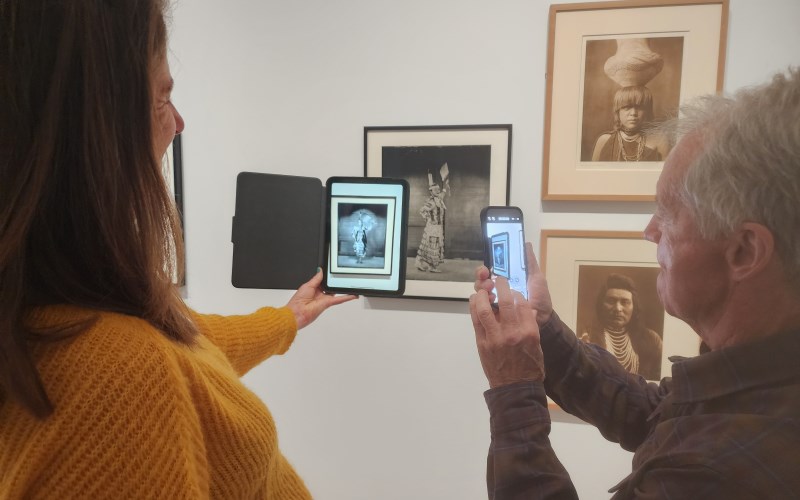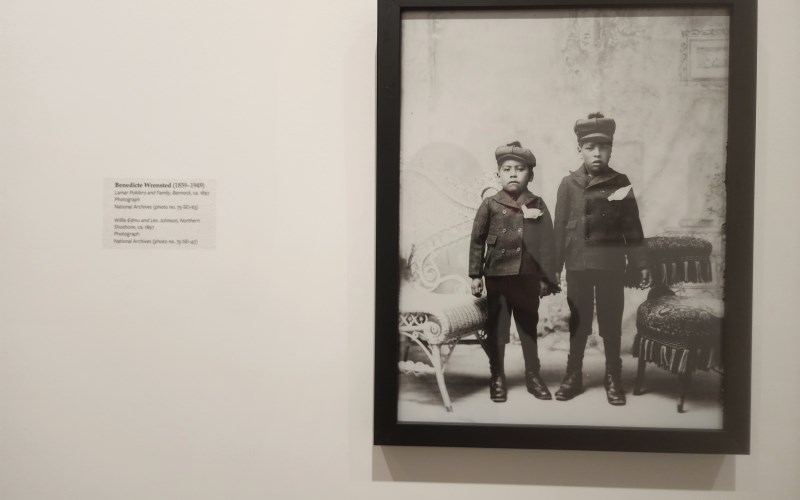|
STORY AND PHOTOS BY KAREN BOSSICK Ava Scanlan pointed the iPad at the portrait photographer Will Wilson had taken of a Native American in the Midwest. Then she watched as the photograph came alive on the iPad, the subject imparting a message. A few minutes later, Orlie Sather downloaded the Talking Tintypes to his smartphone and watched as a jingle dress dancer from the Muckleshoot Nation began dancing. The Talking Tintypes are part of an exhibition currently hanging at the Sun Valley Museum of Art titled “In Conversation: Will Wilson.”
|
|

Orlie Sather watches as a Native American dancer performs a ceremonial dance.
|
|
|
You can see the photographs come alive when the Sun Valley Museum of Art presents a free Evening Exhibition Tour at 5:30 tonight—Thursday, Nov. 21—at The Museum at 5th and Washington streets. The exhibition features portraits that Wilson took to document Native Americans and their ways of life as he traveled throughout Oklahoma in 2016. He photographed more than 200 Native Americans from various Nations in an effort to decenter the photographs that Edward S. Curtis took at the turn of the 20th century that romanticized Native Americans rather than depict them how they truly were. AR technology brings the photographs to life. One, for instance, depicts a Hopi maiden who adopted the hairstyle of Princess Leia and rewrote Leia’s secret message to Obi-Wan Kenobi. The Hopi woman then delivered the message to the leader of the 1680 Pueblo Revolt that drove the Spaniards out of New Mexico.
|
|

Benedicte Wrensted took this photo of two young boys from the Bannock tribe in Idaho in 1897.
|
|
|
Wilson photographed a violinist from the Lummi Nation, who comes alive via AR, and he photographed a Cherokee citizen bearing an image of his great-great grandmother who survived the Trail of Tears in the early 1800s. Will Wilson will give an artist talk at 5:30 p.m. Monday, Dec. 16, at The Museum. Also hanging in the museum are portraits that Danish-American photographer Benedicte Wrensted took of members of the Shoshone Bannock Tribe in her Pocatello photography studio in the late 1800s. Smithsonian researcher Joanna Cohan Scherer found 148 glass plate negatives of hers in the National Archives and over the next decade researchers identified most of the individuals—many of whom have descendants living on the Fort Hall Reservation. The exhibition runs through Jan. 8 so, if you miss tonight’s tour, you can still check out the art from 10 a.m. to 5 p.m. Tuesdays through Fridays and from 11 a.m. to 4 p.m. Saturdays at 191 5th St. E. in Ketchum. Admission is free.
There also will be an Evening Exhibition Tour at 5:30 p.m. Thursday, Dec. 12.
|